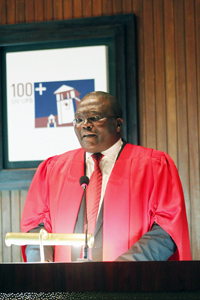The challenges of local governance highlighted at the JN Boshoff Memorial lecture
 Mr Kopung Ralikontsane
Photo: Jerry Mokoroane |
The annual JN Boshoff memorial lecture was hosted by the Faculty of Economics and Management Sciences in conjunction with the Department of Public Management on 21 August 2014. Mr Kopung Ralikontsane, Director-general of the Free State Provincial Government, presented the keynote address, ‘Challenges Facing Local Government in Service Delivery’.
In his opening remarks, Mr Ralikontsane gave the background of the South African municipal structures, the legal framework within which they operate and the challenges they are currently facing. He added that “local government is a sphere at the coalface of service delivery and if this sphere fails, South Africa would have failed to be a developmental state.”
He said the Free State provincial government has made great strides in developing local communities, with millions of rands invested in various development projects such as water and sanitation, electrification, roads and storm water structures, community facilities and solid waste disposal.
Local government is still faced with other challenges, though. He pointed out that public employees are subject to greater scrutiny and increased demands from citizens. As a result, they have to provide better services, but within stricter limits on resources. Conflict arises due to changing relationships between public servants and citizens, downsizing, restructuring and contracting out of government services and activities.
Despite the various structures implemented by local government, municipalities are serving an ever-growing population in an economic decline. Regulations have been put into place to devise credible Integrated Development Plans (IDPs) to improve municipal infrastructure, build competent management teams and strong operations and increase technical capacity for effective delivery of services.
Mr Ralikontsane invited students to join local government in crafting innovative solutions. “We know the problem, but we need to encourage you to join forces with your local government and tackle them.”
Mr Kopung Ralikontsane has served in local government for two decades and also serves as Head of Administration of the Free State Government and as Cabinet Secretary.